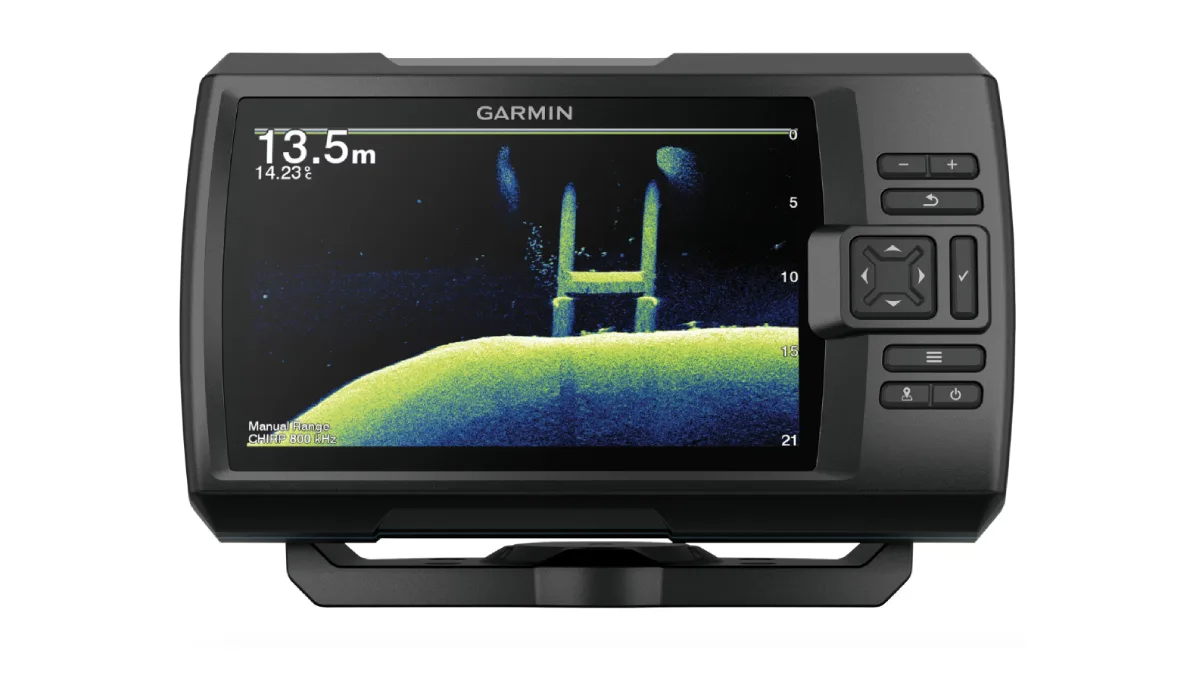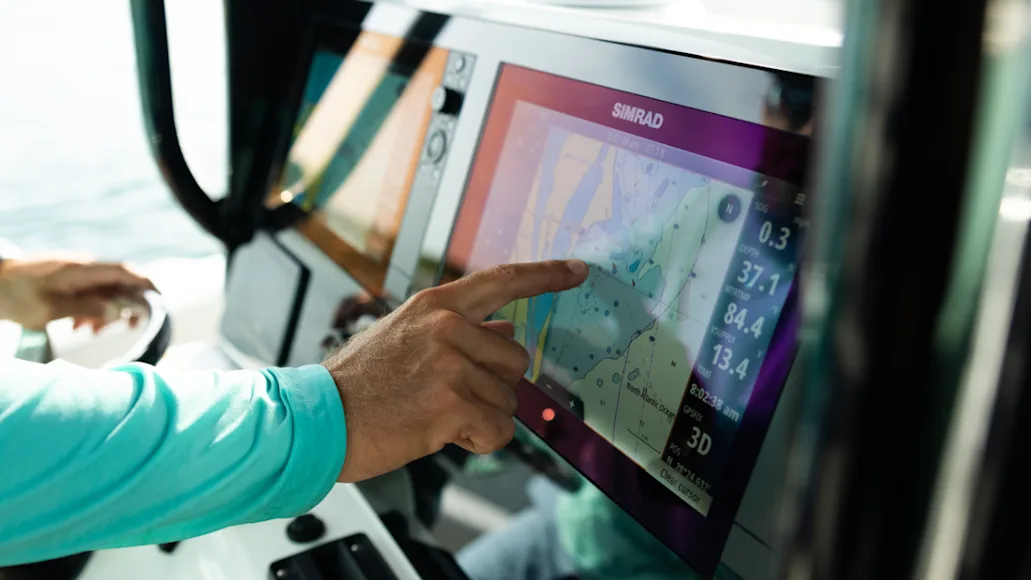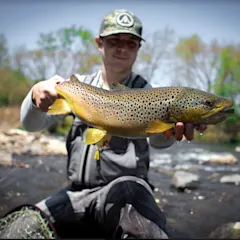_We may earn revenue from the products available on this page and participate in affiliate programs. Learn more ›
_
Best Overall

Humminbird Apex 13 Mega SI+ Chartplotter
Best Budget

Simrad GO9 XSE Chartplotter
Best for Kayak

Garmin Striker Vivid 7sv
Love it or hate it, technology is becoming increasingly intertwined with the outdoors, especially fish finders
. Long gone are the days of putting around a lake and looking for clues as to where the fish might be. Modern fish finders show fish, depth, and structure at just about every angle imaginable. With the increase in technology comes an increase in options for anglers.
Offerings range from basic depth finders to 360-degree fish finders pinpointing entire schools of fish. Is this cheating? It depends on who you ask—but I personally am a big fan. To better understand this technology, I took to the water with every configuration available to find the best fish finders for anglers, whether you’re kayak fishing, ice fishing, or heading out on the open seas. Next time you’re on the water and can’t find the fish, it might be time to consider one of these from Simrad, Humminbird, Lowrance, and Garmin.
The Best Fish Finders
Best Overall: Humminbird Apex 13 Mega SI+ Chartplotter
Best Budget: Simrad GO9 XSE Chartplotter
Best for Kayak: Garmin Striker Vivid 7sv
Best for Ice Fishing: Humminbird Ice Helix 9 MSI+ GPS G4N Mega 360 Bundle
Best Portable: Garmin Striker Cast GPS Castable Sonar
Best GPS Combo: Lowrance Elite FS 7 Fish Finder/Chartplotter Combo
How We Picked the Best Fish Finders
Having spent the better part of my life in and around water, I’ve come to rely on any advantage I can get while fishing—and that includes fish finders.

As an avid angler, I’ve found Garmin fish finders to be some of the top performing time and time again. (Photo/Max Inchausti)
Over the last several seasons, I’ve spent every waking moment on the water I can. In other words, if I’m not working, I’m fishing. I’ve targeted everything from Florida Keys Tarpon to Okeechobee Largemouth and put various fish finders through their paces.
To make the list, a fish finder had to be user-friendly, deliver crisp images, and offer a specific advantage to users. I’ve personally used every fish finder on this list and each one hits these criteria and then some, helping me put more fish in the boat.
Best Overall: Humminbird Apex 13 Mega SI+ Chartplotter
Best Overall

Pros
User-friendly interface
Compatible with other apps for a complete control center
Crisp imaging
Cons
Expensive
Live imaging is the hot new topic in fishing. The combination of a front-facing transducer and crisp images allows you to interact with fish beneath the surface to the point where you can see fish following lures. I tested Humminbird’s Apex 13 with Mega Live Imaging to get a better feel for this technology. The results were astounding.
For starters, I mounted the transducer and Apex unit to the front of my flats boat. Do I get funny looks having a graph on the front of my flats boat? Yes. Do I regret it? Not at all. The head unit itself is a great addition to any boat. It offers incredibly clear images, detailed mapping, and a user-friendly experience. The combination of touchscreen and toggle controls made it easy for me to learn and navigate within minutes of setup.

The technology of this Humminbird fish finder is far superior to any others I’ve used. (Photo/Humminbird)
On new water bodies and deep water fishing scenarios, live imaging proved to be the key to consistently catching fish. The Humminbird Apex 13 took the guesswork of where the fish were out of the equation. Instead, I quickly covered water until I found fish and dialed in what they were interested in. While it may not be for everyone, it’s hard to argue with the effectiveness of live imaging, and I will certainly be finding more uses for it in the near future.
Specs
Screen Size: 13-inch
Interface: Dual touch screen and toggle controls
Available Modes: Side Imaging, Down Imaging, Live Imaging, 360 Imaging
Best Budget: Simrad GO9 XSE Chartplotter
Best Budget

Pros
User-friendly interface
NMEA compatible for full boat compatibility
Full touch screen functionality maximizes screen size
Cons
Slow startup process
The fish finder market is flooded with “budget” options, including a few fish finders under $500
. After using several of these cheaper options, the unfortunate truth is many offer lackluster imaging and can be a pain to use. The exception? The Simrad GO9 XSE, a user-friendly, affordable option offering crisp images.
Since I entered the world of inshore fishing in South Florida years ago, the GO9 XSE has been my main tool to find new water, navigate shallow areas, and, most importantly, find fish. The base model comes with a 3-in-1 transducer complete with side scan, down scan, and traditional sonar. Images are crisp and easy to read, so much so that I rely exclusively on side scans to find tarpon in deeper channels. Believe it or not, I can distinctly pick out their silhouettes and fins.

I love the large high-resolution display of this Simrad fish finder. (Photo/Max Inchausti)
The unit itself is among the most user-friendly I’ve used. Full touchscreen accessibility offers an intuitive means to select screens, create custom split screens, and navigate maps. For the money, the combination of the interface and imaging capabilities makes it hard to beat. The Simrad GO9 XSE has some of the best deals I’ve seen on fish finders.
Specs
Screen Size: 9-inch
Interface: Touchscreen
Available Modes: Side Imaging, Down Imaging
Best for Kayak: Garmin Striker Vivid 7sv
Best for Kayak

Pros
Easy to install
Relatively light
Rugged and durable for kayak use
Cons
Image quality could be better
Modern fishing kayaks are getting closer and closer to traditional power boats every year. With the gap narrowing and technology improving, a fish finder is crucial for any serious kayak angler. The Garmin Striker Vivid 7sv offers everything boat anglers look for in a fish finder but in a kayak-sized package. A 7-inch screen offers the perfect medium between saving space and easy screen viewing. The installation process is straightforward, with a simple bracket mount to secure the graph to the kayak.

For kayak fishing, you really can’t beat this lightweight Garmin Striker. (Photo/Max Inchausti)
For more versatility, a simple swivel mount on the gunwale allows anglers to adjust the fish finder depending on their needs. The transducer is reasonably sized and easy to mount to the transom of a kayak or under the hull (if the kayak has a slot for transducers). Despite its smaller-sized screen, the Striker has all the functionality of its larger counterparts. This includes side imaging, down imaging, and sonar scanning capabilities.
While images are not as crisp as some other larger units, it offers the perfect balance of helpful information in a reasonable-sized package—just what you want in a fish finder for a kayak
.
Specs
Screen Size: 7-inch
Interface: Button controls
Available Modes: Side Imaging, Down Imaging, Sonar
Best for Ice Fishing: Humminbird Ice Helix 9 MSI+ GPS G4N Mega 360 Bundle
Best for Ice Fishing

Pros
Easy to read
Zoom capabilities
Compatible with any Helix transducer for use in boats
Cons
Expensive
Ice fishing can be daunting when covering large bodies of water or new areas. The Humminbird Ice Helix 9 Mega 360 Bundle helps cut this learning curve and find fish through the ice, making it one of the best ice fishing fish finders
. This bundle takes the same 360 Mega Imaging popular on bass boats
and applies it to a mobile unit for ice anglers. Simply drill a hole and set up the transducer pole.
The unit will display a complete 360-degree live image view up to 120 feet from the hole. I can quickly cover large sections on new water bodies and eliminate areas that aren’t holding fish. The ability to pinpoint areas with active fish dramatically reduces the time spent drilling holes and keeps you on fish longer.
Once you find the fish, a small flasher/sonar transducer comes with the kit to dial in on a single fish. While 360 imaging is an investment, anglers looking to explore new water or better understand fish through the ice should look no further. So far, it’s the closest thing I’ve found to seeing underwater.
Specs
Screen Size: 9-inch
Interface: Push button
Available Modes: 360 Live Imaging, Chirp Sonar, Flasher
Best Portable: Garmin Striker Cast GPS Castable Sonar
Best Portable

Pros
Affordable for anglers on a budget
Active mapping creates contour maps of areas where you fish
Can be used on open water or through the ice
Cons
Use heavy lines when casting to avoid losing it
—and more specifically, castable fish finders—are becoming increasingly popular amongst anglers looking to see what’s under the water without access to a boat. One of the best is Garmin’s Striker Cast series.
I hit the water with the Cast GPS version, which offers traditional sonar readings paired with GPS functionality to view maps of the waterway you are fishing. It was by far the easiest to use of all the fish finders I’ve tested. Tie it onto a fishing rod
, cast it, and view the readings through a smartphone. (Just be sure to use a heavy fishing line
to avoid breaking this off; we went with a 65lb braid
.)

I like how easy it is to connect the Garmin Striker Cast to your phone and how well it works. (Photo/Max Inchausti)
The sonar readings are accurate and help pinpoint fish and structure. But the best part about this device is its GPS function to build contour maps. With a series of casts in a “V” formation, the Striker Cast will use sonar readings to build contour maps where you plan to fish. Identifying drop-offs and structure is crucial for bank anglers to find likely areas where fish are hiding. Come winter, this little unit also doubles as a flasher for ice fishing. Drop it in a hole and switch to flasher mode to see individual fish interact with your bait below the ice.
Specs
Screen Size: Screen size depends on the smartphone/tablet you pair it with
Interface: N/A
Available Modes: Sonar and flasher
Best GPS Combo: Lowrance Elite FS 7 Fish Finder/Chartplotter Combo
Best GPS Combo

Pros
Easy to use
High-definition mapping and active contour maps
A rugged system that stands up to hard use
Cons
Small screen size
Before becoming a writer, I spent several years as a fisheries biologist in South Florida. Good mapping was crucial with much of the time spent on the water, navigating vast wetlands and lakes. I came to rely heavily on the Lowrance Elite FS 7-inch fish finder.
This unit is easy to set up with minimal rigging. Run the transducer from the transom, mount the unit, and hook it up to power. Once it is ready to go, I found that learning the unit is incredibly simple. It’s a touchscreen, so navigating between screens is a breeze. The base model comes ready with side imaging, down imaging, and sonar.
The Elite FS also comes with detailed maps from the factory showing base depth on various water bodies. For a more detailed approach, live mapping can create detailed contours of specific areas or entire water bodies. After nearly 500 days of on-the-water use and rough use at that, this unit held up just as the day it was installed. Safe to say, I’m a huge fan.
Specs
Screen Size: 7-inch
Interface: Touch screen and toggle buttons
Available Modes: Side Imaging, Down Imaging, Sonar
What to Look For in a Fish Finder
Everyone has their own preferences when it comes to fish finders. Some are brand loyal, and some want the best fit for their boat. Regardless of where you land, your equipment has to be capable of delivering the information you need and holding up to the elements on the water.
Interface
There are two main types of interfaces on fish finders: touchscreen and button controls. Each offers its own benefits on the water. Touchscreens are intuitively easy to learn to use. Selecting screens, dropping waypoints, and navigating maps can all be done at the touch of a button. Button controls can take a little more getting used to but are great when things get wet. Wet and cold fingers don’t always register well on a touch screen but are great for button-controlled units.
For those wanting the best of both worlds, a hybrid option lets you operate in either manner.
Fishing Style
How you fish is a critical part of determining what fish finder is best for you. Anglers fishing deep water for schooling fish should seriously consider live imaging. The ability to see active schools of fish will drastically cut down on the time searching for fish and will translate to more fish hitting the deck.
For anglers fishing rivers or areas with heavy structure, a good side imaging fish finder
is a must. This lets you pick apart structures from a distance before making casts to likely areas. If you find yourself on the ice in the winter, look for units that can easily be switched between boats and ice fishing setups, like the Humminbird Helix 9
.
Price
Fish finders vary widely in price, from budget options to some that cost as much as small boats. Once you’ve narrowed down what options you need in a unit, set a budget. There are plenty of great units on the market. While the bigger screen is always nice, if it means saving money that can go to more fishing gear, I tend to lean toward the smaller screen, especially if the functionality is the same.
FAQs
Q: What fish finder has the best side imaging?
Side imaging is an integral part of most fish finders these days. All major brands offer excellent image quality and straightforward interfaces. That said, I’ve had particularly good luck with the Simrad GO9 XSE
. Its full touchscreen interface takes up the entire housing. This reduces the overall size of the unit while maximizing the screen size. The end result is crisp images that are easy to view.
Q: How does a fish finder work?
Fish finders work by emitting a sonar pulse from the transducer. The signal travels through the water until it hits an object like a fish or structure. It then bounces back to the transducer, showing up as a blip on the fish finder.
Side and down imaging work similarly but with smaller beams emitted from the transducer. The unit compiles a series of these beams to create a detailed image of the bottom contour.
Q: How do you read a fish finder?
is easier than it looks. After the sonar waves bounce off a fish and return to the transducer, the unit displays them as “U” shaped blips. The bigger the blips, the bigger the fish. When the fish finder reads these signals, it simultaneously calculates the depth of the fish. Look at the position of the blip and the corresponding depth markers to see how deep the fish is.
What Is the Best Fish Finder?
Fish finders are an integral part of modern fishing. Using them to your advantage will result in consistently landing more fish. They are a valuable tool and can take time to learn and dial in for specific fisheries. Our favorite that we’ve used on the water is the Humminbird Apex 13 Mega SI+
for its user-friendly interface and incredibly clear imaging. But there are countless other options available, some that are good and some that are game-changing. Figure out what you need, and your investment will help you catch fish for years.
Best Overall: Humminbird Apex 13 Mega SI+ Chartplotter
Best Budget: Simrad GO9 XSE Chartplotter
Best for Kayak: Garmin Striker Vivid 7sv
Best for Ice Fishing: Humminbird Ice Helix 9 MSI+ GPS G4N Mega 360 Bundle
Best Portable: Garmin Striker Cast GPS Castable Sonar
Best GPS Combo: Lowrance Elite FS 7 Fish Finder/Chartplotter Combo
Why Trust Us
For more than 125 years, Field & Stream has been providing readers with honest and authentic coverage of outdoor gear. Our writers and editors eat, sleep, and breathe the outdoors, and that passion comes through in our product reviews. You can count on F&S to keep you up to date on the best new gear. And when we write about a product—whether it’s a bass lure or a backpack—we cover the good and the bad, so you know exactly what to expect before you decide to make a purchase.






